Introduction
When venturing into the world of e-commerce, creating a successful Magento website requires careful planning, strategic decision-making, and meticulous execution. To ensure a seamless user experience that aligns with your business objectives and the latest market trends, it's crucial to blueprint the architecture and core functionalities of your site. This article will guide you through the essential steps of researching and planning your website, choosing a web host and domain name, preparing for Magento installation, installing Magento, selecting a Magento theme, configuring store settings, importing product data and setting up the catalog, configuring payment and shipping methods, testing and optimizing your website, launching your Magento website, and finally, monitoring and maintaining your website.
By following these expert-recommended steps, you'll lay the foundation for a thriving e-commerce venture and position yourself as a leader in the dynamic digital marketplace.
Step 1: Research and Plan Your Website
When designing your Magento e-commerce website, it's crucial to strategically blueprint the structure and core functionalities to ensure a seamless experience that aligns with your business objectives and the latest market trends. Start by pinpointing your ideal customer profile to tailor your website's design and offerings to their preferences and behaviors, enhancing the likelihood of engagement and conversion.
Next, explore competitor analysis to extract actionable insights on their strategies and interfaces. This exercise not only helps in differentiating your platform but also in enhancing the overall experience by integrating superior design elements and customer-centric features.
Constructing a well-organized sitemap is the next critical step, which serves as a navigational guide for your content structure, ensuring users can find what they're looking for with ease. Coupled with this is the identification of pivotal functionalities like a robust product catalog, intuitive shopping cart, secure payment gateway, and efficient customer account management. These characteristics are essential for a flourishing online shopping platform and can be enhanced with the appropriate extensions and plugins.
By integrating the most recent advancements in online business, such as AI-powered personalization, the shopping experience can be greatly improved by providing customized content and recommendations to every user. Keeping abreast of these developments is essential to maintaining a competitive edge in the dynamic digital marketplace.
Finally, acknowledging the importance of data privacy and protection is paramount in today's digital ecosystem. Ensuring compliance with data protection standards and providing transparent cookie policies contribute to building trust and credibility with your audience.
By meticulously addressing these aspects, you lay down a robust foundation for your online shopping website, poised for success in the evolving digital retail landscape.
Step 2: Choose a Web Host and Domain Name
Choosing the correct web hosting service and domain name is a crucial step in launching a successful Magento online business site. Start by investigating Magento-optimized hosting providers that are known for their reliability and support. Key considerations should include server uptime, scalability options, advanced security measures, and responsive customer service.
When assessing hosting plans, align the features with your specific needs—traffic expectations, storage requirements, bandwidth, and database capabilities should all guide your decision. It's not just about finding a cost-effective solution but one that will grow with your e-commerce business.
Choosing a domain name is another critical decision; it should resonate with your brand while being easy to remember and type. Take advantage of domain registration services to secure your brand's virtual address.
Once you've made your choices, initiate the setup with your hosting provider. Carefully follow their guidelines to connect your domain to your new web space, ensuring all DNS settings are correctly configured for unhindered access to your site.
Remember, your online presence hinges not just on the aesthetics and functionality of your website but also on the backend foundations you lay with your hosting and domain decisions. Choose wisely to provide your visitors with a seamless shopping experience.
Step 3: Prepare to Install Magento
Preparing your server environment for the installation of the e-commerce platform is a critical step in ensuring a seamless setup process. Let's delve into the key actions you need to take:
-
Check the Magento system requirements carefully. Confirm that your web server has the necessary software versions, supports the required PHP extensions, is compatible with the database system, and has proper server configurations in place.
-
Set up a separate database for your store on the platform. This is typically done through your hosting control panel or by employing a database management tool.
Secure your files and directories by setting permissions according to the recommended guidelines of the platform. This safeguards your store against unauthorized access and potential security threats.
-
Activate all necessary PHP extensions, such as OpenSSL, PDO MySQL, and SOAP, which may not be enabled by default on your server.
-
If your online store will be handling sensitive data, configure an SSL certificate for encrypted data transmission, bolstering the security of customer information.
By carefully following these steps, you're laying the foundation for a successful installation and powerful online trading platform similar to the infrastructure that powers Chess.com, which serves millions of users daily and requires a combination of public cloud and on-premises solutions for a stable IT framework. As you embark on this journey, remember to keep your infrastructure flexible and scalable to accommodate growth, much like Chess.com's approach to serving its global community with a digital platform that unites chess enthusiasts from different corners of the world.
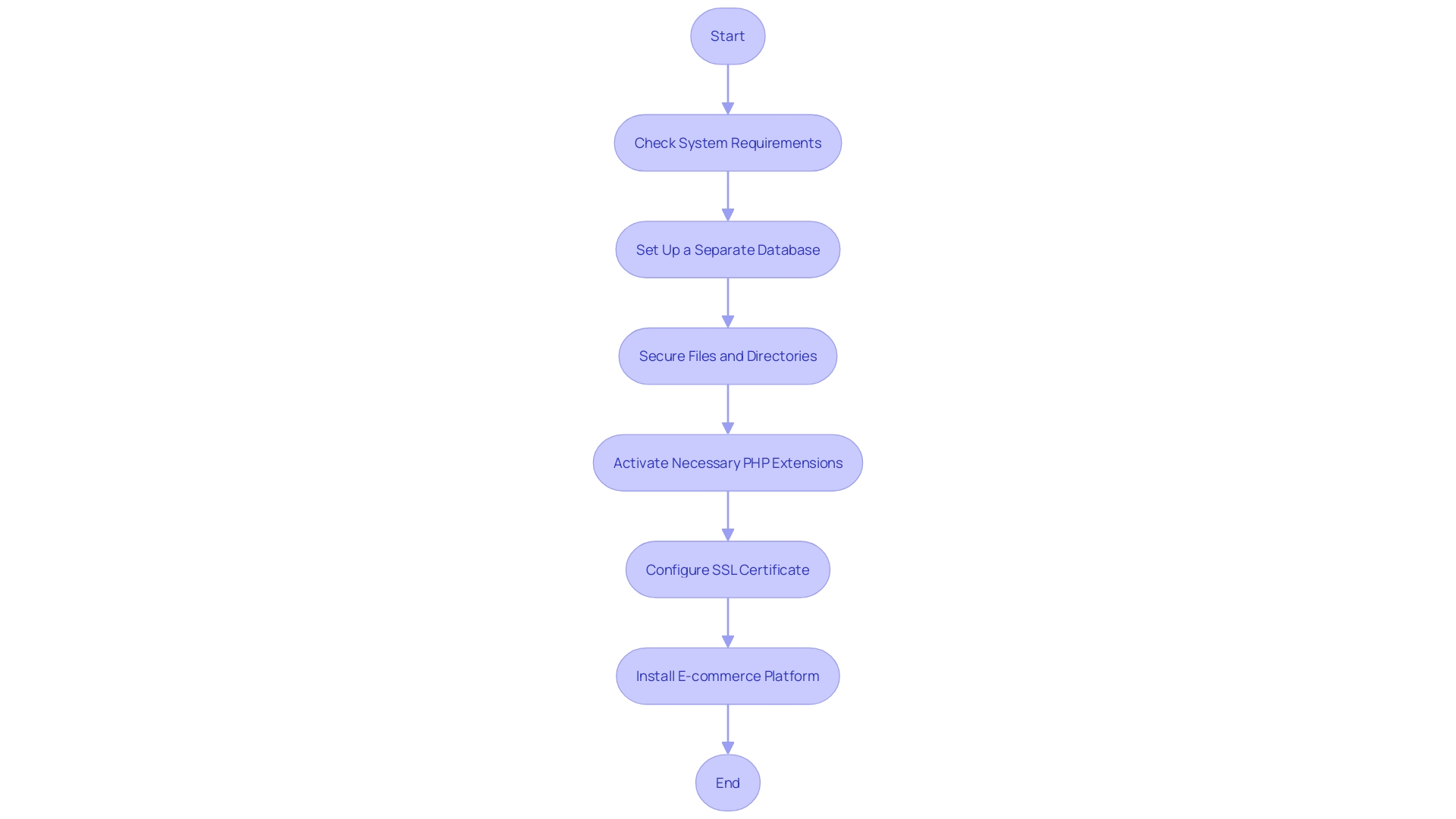
Step 4: Install Magento
Establishing your e-commerce platform is a vital undertaking that demands accuracy and comprehension of the underlying server environment. To start the installation process of the ecommerce platform, the first step involves downloading the most recent version from the official website. It's imperative to select the package that aligns with your server specifications and business needs.
Once downloaded, the files must be uploaded to the server. This can be accomplished via File Transfer Protocol (FTP) or directly through your web hosting control panel. Proper placement of these files in the designated directory is crucial for the successful deployment of the platform.
The next phase is to run the installation wizard, which is accessible via a web browser. This wizard is designed to facilitate the installation process by prompting you to input essential information such as database configurations, administrative credentials, and store settings.
The final step in the installation is to meticulously follow the wizard's instructions. Upon completion, you will be rewarded with a fresh installation, ready to be tailored to your unique business requirements.
Although Magento offers a strong base for your online business ventures, it is crucial to take into account alternative platforms such as Drupal and ClassicPress. These platforms provide a wide range of functionalities such as advanced APIs, diverse themes, and user-friendly content management systems, which enhance the flexibility and control of your online presence.
Additionally, staying updated on the latest in software installation, such as the addition of Python support in ispmanager, or security vulnerabilities reported by bug bounty partners, is crucial for maintaining a secure and efficient online business platform. Moreover, the utilization of SSL certificates and comprehending the consequences of server specifications are crucial elements that should not be disregarded when handling an online trading platform.
As the online business sector flourishes, with the worldwide B2B eCommerce market expected to rise at a compound annual growth rate of 20.2% from 2023 to 2030, utilizing the Business Intelligence tools offered by a popular e-commerce platform can be a game-changer in utilizing analytical insights to surpass rivals and attain continuous expansion in the digital marketplace.

Step 5: Select a Magento Theme and Customize
Choosing an attractive theme that combines style and functionality is a crucial step for building a captivating online shopping experience. Here's how to find and personalize a Magento theme that elevates your online store:
-
Identify Your Website's Purpose: Whether you're building a blog, e-commerce platform, or portfolio, choose a Magento theme that's specifically designed for your site's objective to ensure a cohesive user experience.
-
Prioritize Mobile Responsiveness: With over half of global web traffic originating from mobile devices, a responsive theme is non-negotiable. Users are more inclined to revisit and recommend mobile-friendly sites, and a responsive design is key to keeping potential customers engaged and reducing bounce rates.
-
Discover Theme Options: Venture into the Marketplace or trusted theme vendors to explore themes that resonate with your brand's aesthetic and functional needs. Pay attention to layout, responsiveness, customization capabilities, and user feedback to inform your choice.
-
Installation and Activation: After choosing your theme, download the required files and follow the provided instructions to install and activate the theme on your platform.
-
Theme Customization: Employ Magento's built-in customization features to align the theme with your brand's identity. Adjust elements like color schemes, typography, logos, and the homepage layout to distinguish your online presence.
-
Testing and Optimization: Post-customization, rigorously test your site on various devices and web browsers to ensure a consistent and flawless interface for individuals who access it. Optimize for speed to cater to users' expectations of rapid loading times, which can substantially improve conversion rates.
Utilizing these steps will assist you in creating a storefront that is not only visually captivating but also provides a seamless and user-friendly shopping experience that appeals to today's discerning online shoppers.
Step 6: Configure Store Settings
Building a remarkable online shopping experience is crucial for attracting and retaining buyers. Begin by configuring your Magento store to display crystal-clear product images promptly. Achieving this balance between high-quality visuals and swift loading times is key, as it encourages visitors to explore and purchase more products.
Next, set up comprehensive store information, including your store name, address, contact details, and business policies. This openness forms the foundation of trust and is essential to the shopping experience, mirrored throughout your website, invoices, and transactional emails.
Payment methods should be diverse and user-friendly. Incorporate options like credit card payments, PayPal, or other payment gateways, and ensure they are seamlessly integrated. The convenience of payment options can significantly impact conversion rates.
Shipping methods are another critical area. Offer a variety of choices, such as flat rate shipping or free shipping, and tailor your shipping rules, rates, and restrictions to your products and target regions. This adaptability caters to client preferences and enhances the likelihood of repeat business.
Taxes, though often complex, must be precisely configured. Set up tax classes, rates, and rules in alignment with your business location and the tax regulations of your target markets to ensure compliance and accurate tax calculation.
Finally, transactional emails should be personalized to mirror your brand identity, offering distinct and professional communication with clients. This attention to detail in order communications can foster a strong brand-customer relationship.
By emphasizing these areas, you can enhance your store's administration and interact with your customers more effectively, as demonstrated by recent improvements in popular eCommerce platforms that now provide dashboard insights and enhanced order management interfaces. As the global B2B eCommerce market continues to grow, these improvements are essential for staying competitive and ensuring your store's success.
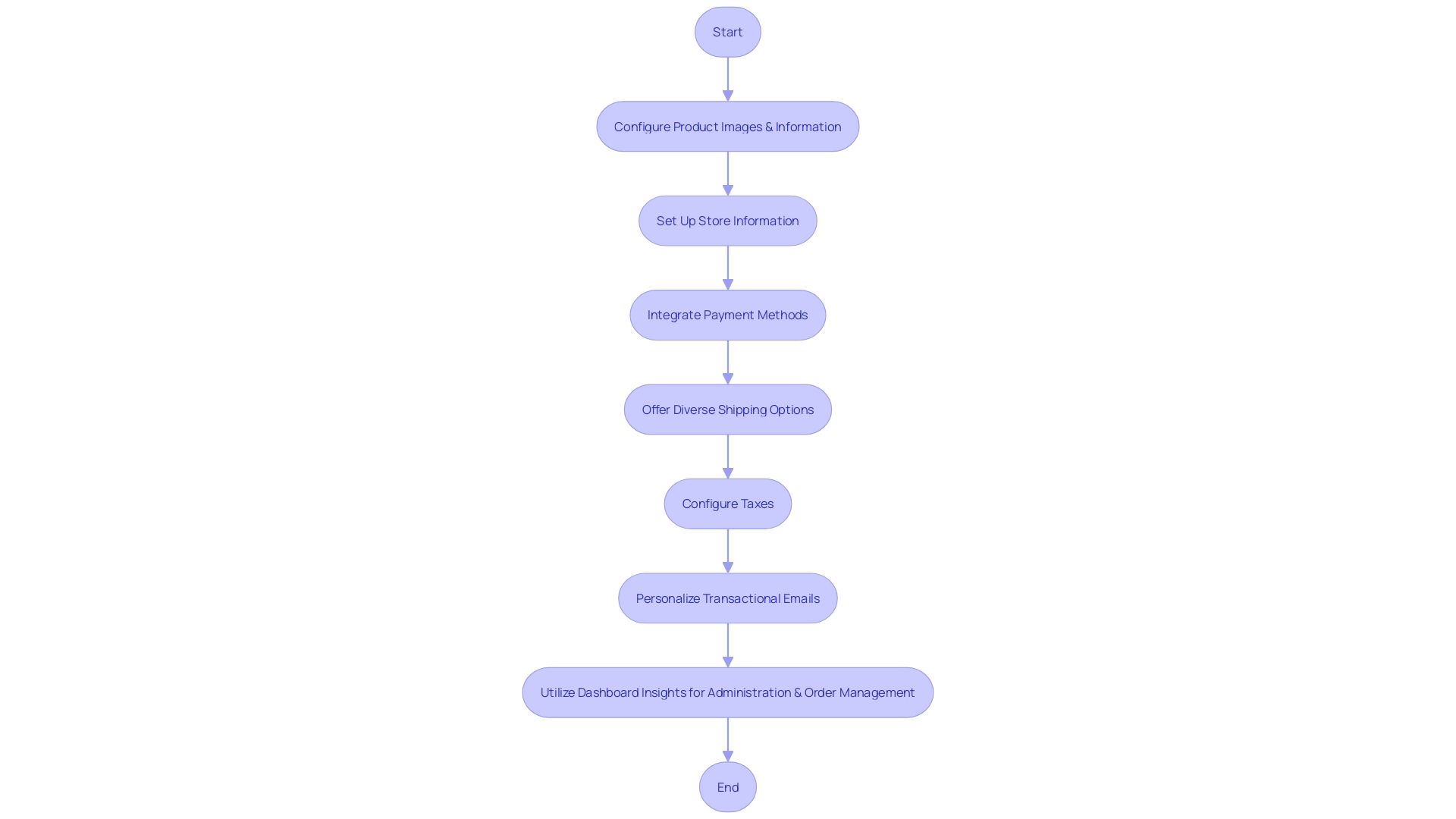
Step 7: Import Product Data and Set Up Catalog
Developing a successful product catalog on a popular e-commerce platform is essential for the prosperity of your online business. It's not just about listing your products; it's about crafting a comprehensive digital directory that serves as a central source of truth for your business.
Start by meticulously preparing your product data. Ensure you have detailed titles, descriptions, high-resolution images, competitive prices, and specific attributes for each item. This information should be systematically organized, frequently in a CSV format, allowing for streamlined importation.
Once your data is prepped, initiate the import process using Magento's native tools or opt for reliable third-party extensions. It's imperative to carefully map your data fields during this step to guarantee that your products are accurately represented within the system.
Defining custom product attributes is the next crucial step. Whether it's size, color, material, or unique identifiers like UPC codes, these details enhance the searchability and desirability of your products. These attributes should align with your industry standards and inquiries, ensuring that each product is as informative as possible.
The organization extends to product categorization. By establishing intuitive categories and subcategories, you'll not only streamline the user experience but also bolster the efficiency of your inventory management. Appropriate classification guides individuals smoothly through your product range, similar to a well-organized physical store.
Lastly, the optimization of product listings cannot be overstated. Engaging, SEO-rich descriptions paired with high-quality images elevate your products above the competition. Reflect on the sales growth of brand owners on Amazon, where a 20% increase was observed due to such strategies. This optimization also plays a pivotal role during high-traffic events like Amazon's Great Indian Festival, where well-listed products stand out amidst heavy discounts and offers.
By embracing these systematic steps, your product catalog will not only attract but also retain buyers, laying the foundation for a prospering online business.

Step 8: Configure Payment and Shipping Methods
To guarantee a smooth shopping experience for your Magento website clients, payment and shipping configurations are crucial. Here's how you can optimize these crucial elements:
- Integrating Payment Gateways: Secure online transactions are the backbone of any e-commerce platform. By incorporating payment providers such as Stripe, which offers a unified payment system, you can provide a seamless checkout experience. Don't forget to rigorously test the payment flow to verify its efficiency and safeguard against potential fraud.
Customized shipping options are crucial for addressing diverse client requirements. Detailing your shipping practices, including carriers, rates, and rules, is crucial. This also means setting parameters for package dimensions, weight limits, and handling fees, to accommodate the various products you offer and the regions you serve.
-
Streamlining Order Fulfillment: An efficient order fulfillment process includes timely confirmation emails, robust inventory management, and real-time order tracking. This guarantees individuals are well-informed at every stage, from purchase to delivery.
-
Giving Priority to Website Security: Safeguarding the data of individuals who interact with your website through SSL certificates, CAPTCHA verifications, and robust fraud detection systems is non-negotiable. It's not just about security but also about establishing trust with your clients.
Remember, personalizing the payment process can significantly influence customer purchasing decisions. As Blair Williams suggests, offering localized payment experiences and the option to save payment details enhances the ease of purchase. This, combined with keeping your product ordering system straightforward, as seen with the new drag-and-drop reordering feature, can markedly improve user experience on your site.
By following these steps, you not only create a dependable and customer-focused online platform but also position your site for long-term success in the digital marketplace.
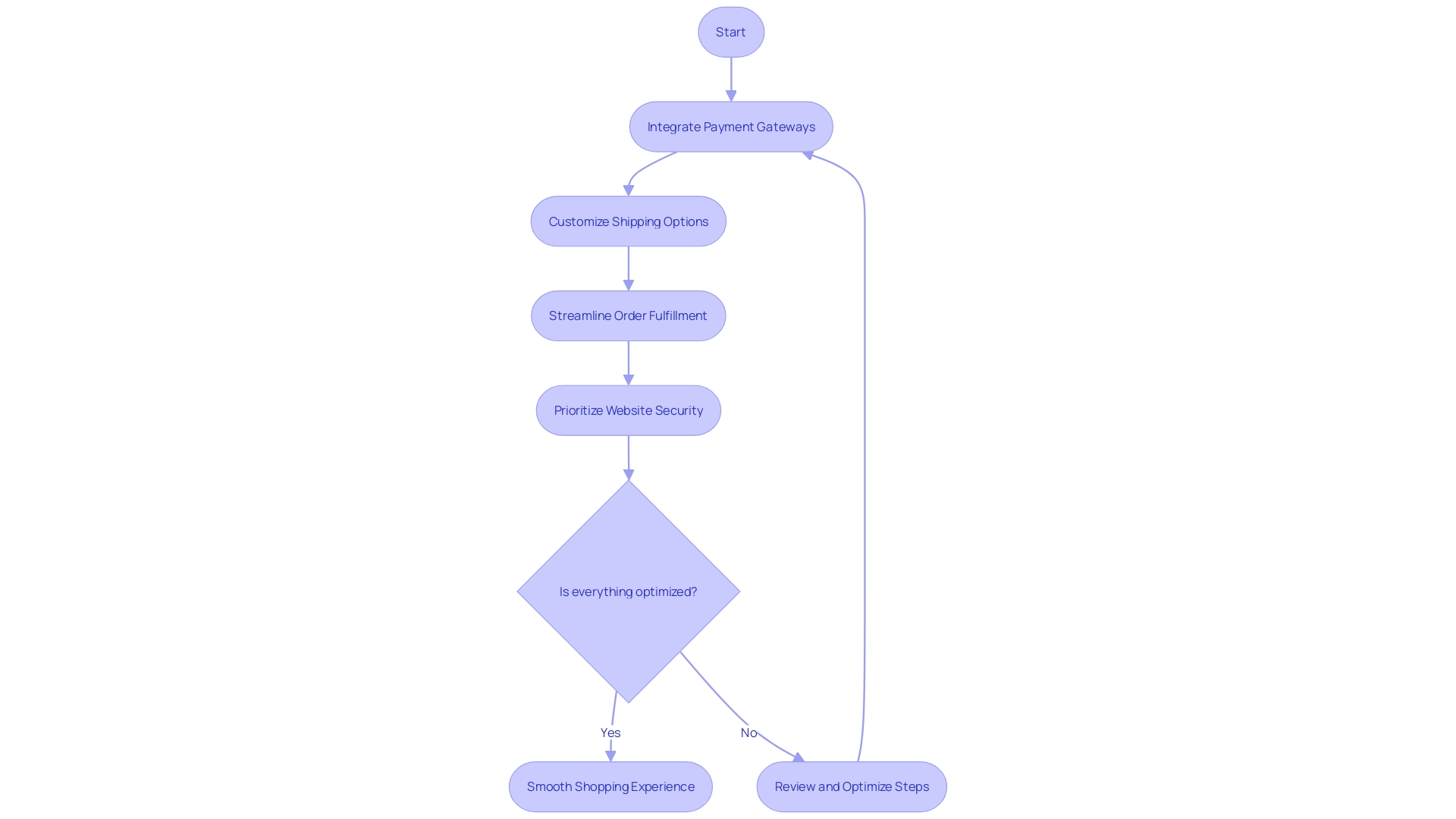
Step 9: Test and Optimize Your Website
When it comes to optimizing a Magento or WordPress e-commerce website, learning from industry leaders can be incredibly insightful. For example, Zalando, a major name in online fashion, emphasizes the importance of thorough IT systems testing to handle peak demand times. Likewise, Elkjøp, a prominent omnichannel retailer, emphasizes providing an online experience that individuals can rely on as they would trust a store associate's guidance. These insights underline the need for a comprehensive approach towards website optimization.
-
Functional Testing: It's not just about ensuring that customers can browse and add items to their cart; it's about guaranteeing a smooth journey right through to checkout. This step is crucial in identifying and fixing any possible disruptions in the experience of the individual.
-
Cross-Device Compatibility: With users accessing sites from various devices and browsers, it's essential to test and ensure that your website maintains functionality and design integrity across all platforms, including Chrome, Firefox, Safari, and Edge.
-
Speed Optimization: Speed is a pivotal factor in user retention and conversion. Techniques like image compression, CSS and JavaScript file minification, caching, and utilizing CDNs are instrumental in enhancing your website's loading times.
-
User Experience Testing: Obtaining feedback from real users is invaluable. It provides a window into how intuitive and user-friendly your website truly is, allowing you to make data-driven adjustments for a better customer experience.
-
Analytics and Tracking: Tools such as Google Analytics offer a wealth of information about how users interact with your site. By comprehending performance, audience behavior, and conversion metrics, you can enhance your website to better meet the needs of your target market.
In the banking industry, as shown by First Midwest Bank's innovative approach to A/B testing, challenging conventional methods can lead to notable increases in conversion rates. This demonstrates the significant impact that creative testing and optimization strategies can have, even in traditionally conservative sectors.
The development team at Automattic also illustrates the importance of performance improvements, sharing their journey in enhancing WordPress's code. As they prepare for the release of WordPress 6.3, they highlight the significance of code that is readable, secure, correct, and performant. This approach ensures that the software not only meets the high expectations of users but also contributes to a more robust and reliable platform.
Combining these approaches with the latest website statistics and trends, such as those provided by 9cv9, gives a comprehensive picture of the online landscape. In a digital world where an estimated 1.13 billion websites exist, standing out requires a commitment to ongoing testing, optimization, and adaptation to the ever-changing demands of online business.

Step 10: Launch Your Magento Website
When the moment arrives to unveil your Magento e-commerce platform to the world, meticulous preparation is key. Here's a streamlined approach to ensure a flawless launch:
-
Begin with a comprehensive review of your site, scrutinizing everything from the content and design to the intricacies of functionality and user settings. This preemptive check ensures that all elements align perfectly with your vision and operate without a hitch.
-
Embrace the essentials of SEO to bolster your online visibility. This involves crafting meta tags that resonate with your brand, structuring URLs for optimal indexing, devising a sitemap to guide search engines, and announcing your digital presence to these search giants.
-
Safeguard your hard work by backing up your site's data and files. This safety measure is crucial, providing a fallback solution should any complications arise during your site's initial outing.
-
For those transitioning to a new domain or hosting environment, updating DNS records is a must. This pivotal step directs traffic to your new digital abode, ensuring seamless access for your audience.
-
Post-launch vigilance is indispensable. Monitor your site's performance, stay attuned to feedback from individuals, and be ready to swiftly tackle any teething problems. This attentiveness is vital in offering a polished user experience from day one.
Equipped with this organized strategy and a concentration on excellence, your site's launch in the online business domain is positioned to have a significant influence.
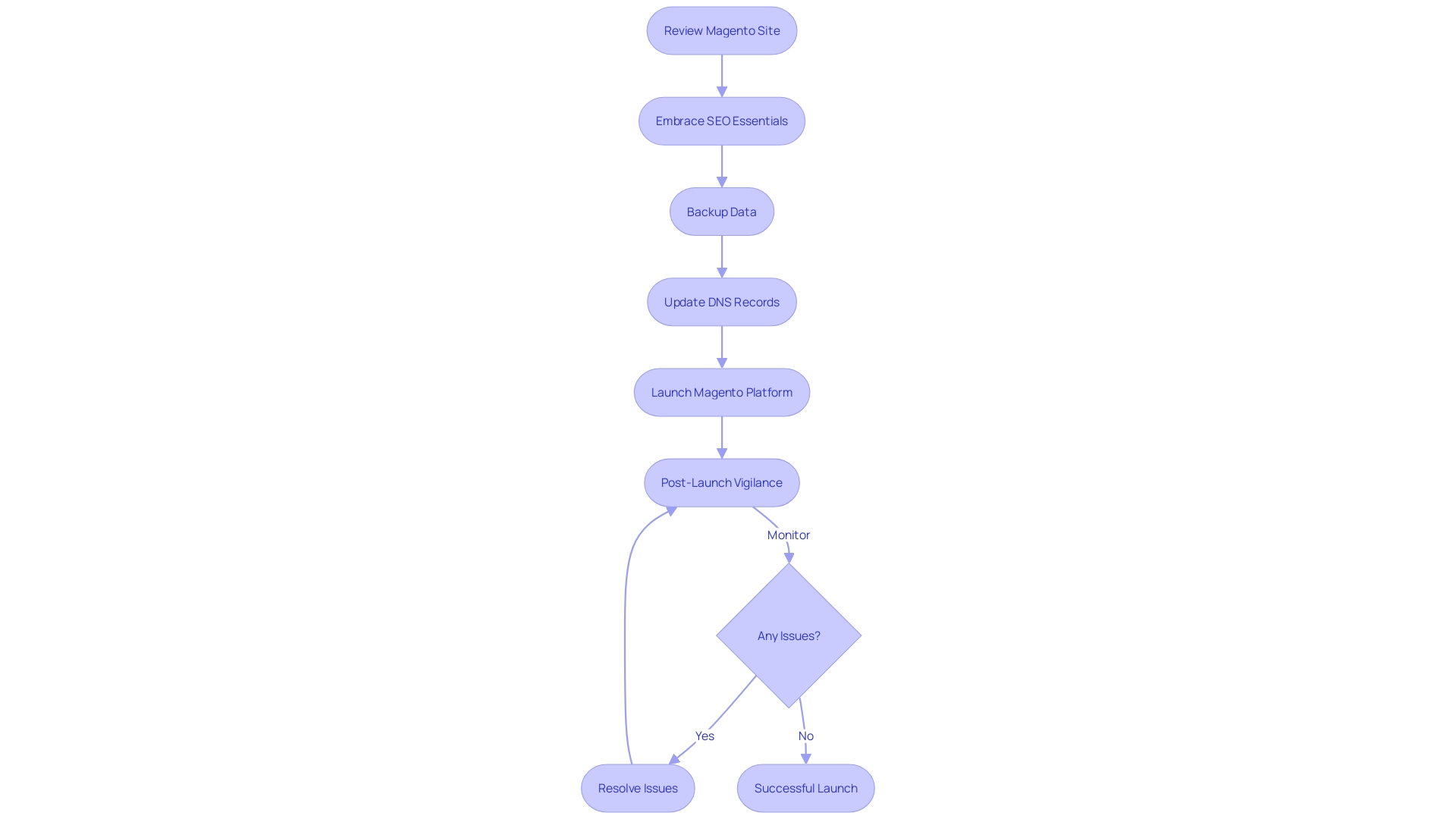
Step 11: Monitor and Maintain Your Website
To maintain a robust Magento e-commerce platform, it is vital to keep the system up to date with the latest versions and security patches. This not only unlocks new features but also ensures that any identified bugs are fixed, reducing the risk of security vulnerabilities. For instance, the recent Version 8.1.2 release addressed various security concerns and enhanced the experience of individuals with more transparent error messages and availability checks following updates. These enhancements are crucial for businesses to maintain a competitive edge, as indicated by the 43% of small businesses looking to invest in their website performance.
Monitoring website performance is another key aspect to consider. With over 1.11 billion websites on the internet and a daily increase, uptime monitoring becomes a non-negotiable aspect of maintaining a positive individual experience. An effective monitoring tool can help identify performance dips or bottlenecks that could otherwise go unnoticed until they affect the experience or sales.
Regular website backups are essential for data protection, as they mitigate the risks of data loss due to unforeseen events. A comprehensive backup strategy will ensure that your e-commerce operations can be quickly restored, minimizing downtime and preserving customer trust.
Security is another critical area, given the constant evolution of online threats. Implementing robust security measures such as firewalls and intrusion detection systems, as well as regular vulnerability scans, is fundamental to safeguard your platform. This proactive approach to security is exemplified by OracleCMS's recent cyber incident response, where expert-led investigations and containment measures ensured the integrity of their IT environment.
Lastly, the continuous analysis of website analytics provides insights into user behavior and the overall effectiveness of your digital marketing efforts. Utilizing tools like Google Analytics can help pinpoint areas for improvement and optimize both website performance and marketing strategies, thus leveraging the power of data to drive growth and success.
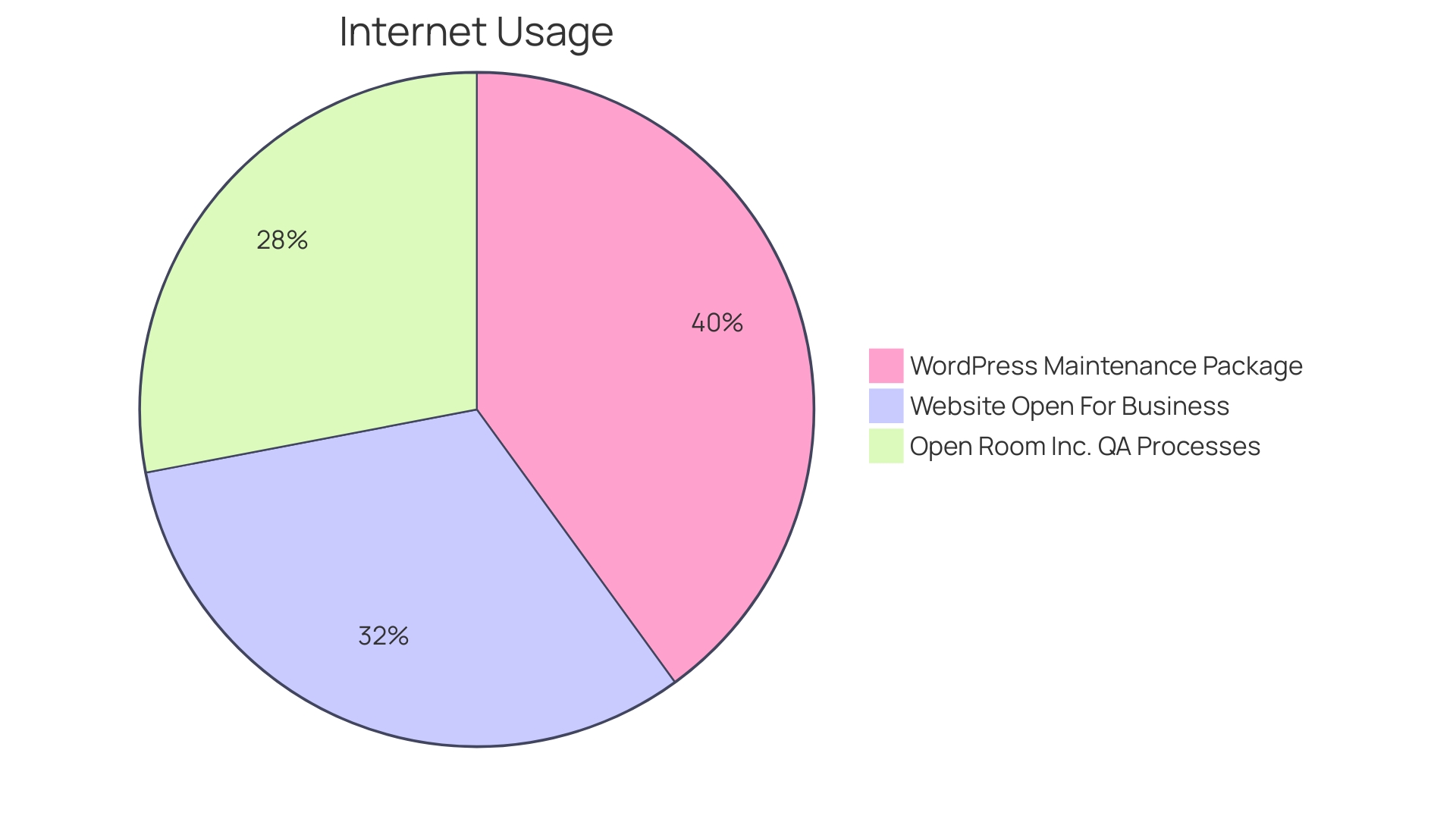
Conclusion
In conclusion, creating a successful Magento e-commerce website requires careful planning, strategic decision-making, and meticulous execution. By following the expert-recommended steps outlined in this article, you can lay the foundation for a thriving e-commerce venture and position yourself as a leader in the dynamic digital marketplace.
Research and plan your website, considering your ideal customer profile and conducting competitor analysis to enhance the user experience. Choose a reliable web host and a memorable domain name that aligns with your brand.
Prepare for Magento installation by checking system requirements, securing files and directories, and configuring SSL certificates for data encryption. Install Magento by downloading the latest version, uploading files, and following the installation wizard. Consider other platforms for flexibility and stay informed about software updates and security vulnerabilities.
Select a Magento theme that combines style and functionality, customize it to reflect your brand identity, and optimize the user experience. Configure store settings, including displaying clear product images, setting up comprehensive store information, and integrating diverse payment and shipping methods.
Import product data and set up the catalog meticulously, ensuring detailed information and optimized listings. Configure payment and shipping methods to provide a frictionless shopping experience. Test and optimize your website for functionality, compatibility, speed, user experience, and analytics.
When launching your Magento website, review it thoroughly, embrace SEO best practices, back up your data, and update DNS records if necessary. Monitor and maintain your website by keeping it up to date, monitoring performance, conducting regular backups, implementing robust security measures, and analyzing website analytics.
By following these steps and staying informed about industry trends, you can establish yourself as an industry expert and ensure the success of your Magento e-commerce venture in the competitive digital marketplace.





